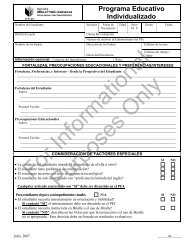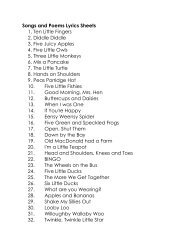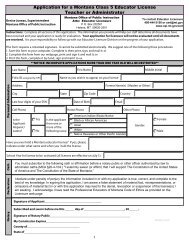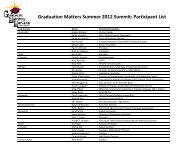Appendix B: Text Exemplars and Sample Performance Tasks
Appendix B: Text Exemplars and Sample Performance Tasks
Appendix B: Text Exemplars and Sample Performance Tasks
You also want an ePaper? Increase the reach of your titles
YUMPU automatically turns print PDFs into web optimized ePapers that Google loves.
Common Core State St<strong>and</strong>ards for english language arts & literacy in history/social studies, science, <strong>and</strong> technical subjects<br />
When I look at the moon <strong>and</strong> the stars, I use one sense. I am seeing.<br />
When I laugh <strong>and</strong> play with my puppy, I use four senses. I see, hear, smell, <strong>and</strong> touch.<br />
When I bounce a ball, I use three senses. I see, hear, touch.<br />
Sometimes I use more of one sense <strong>and</strong> less of another.<br />
But each sense is very important to me, because it makes me aware.<br />
To be aware is to see all there is to see…<br />
hear all there is to hear…<br />
smell all there is to smell…<br />
taste all there is to taste…<br />
touch all there is to touch.<br />
Wherever I go, whatever I do, every minute of the day, my senses are working.<br />
They make me aware.<br />
COPYRIGHT © 1962, 1989 BY ALIKI BRANDENBERG. Used by permission of HarperCollins Publishers.<br />
Hurd, Edith Thacher. Starfish. Illustrated by Robin Brickman. New York: HarperCollins, 2000. (1962)<br />
Starfish live in the sea. Starfish live deep down in the sea. Starfish live in pools by the sea.<br />
Some starfish are purple. Some starfish are pink.<br />
This is the sunflower starfish. It is the biggest of all. Starfish have many arms. The arms are called rays. Starfish have<br />
arms, but no legs.<br />
Starfish have feet, but no toes. They glide <strong>and</strong> slide on tiny tube feet. They move as slowly as a snail.<br />
The basket star looks like a starfish, but it is a little different. It doesn’t have tube feet. It moves with its rays. It has<br />
rays that go up <strong>and</strong> rays that go down.<br />
Tiny brittle stars are like the basket star. They hide under rocks in pools by the sea.<br />
The mud star hides in the mud. It is a starfish. It has tiny tube feet.<br />
A starfish has no eyes. A starfish has no ears or nose. Its tiny mouth is on its underside. When a starfish is hungry, it<br />
slides <strong>and</strong> it glides on its tiny tube feet.<br />
It hunts for mussels <strong>and</strong> oysters <strong>and</strong> clams. It feels for the mussels, It feels for the oysters. It feels for the clams. It<br />
feels for something to eat.<br />
The starfish crawls over a clam. Its rays go over it. Its rays go under it. Its rays go all over the clam. The starfish pulls<br />
<strong>and</strong> pulls. It pulls the shells open. It eats the clam inside.<br />
Sometimes a starfish loses a ray. A crab may pull it off. A rock may fall on it. But this does not hurt. It does not<br />
bother the starfish. The starfish just grows another ray.<br />
In the spring when the sun shines warm, <strong>and</strong> the sea grows warm, starfish lay eggs. Starfish lay eggs in the water.<br />
They lay many, many, many tiny eggs. The eggs look like s<strong>and</strong> in the sea. The tiny eggs float in the water. They float<br />
up <strong>and</strong> down. They move with the waves <strong>and</strong> the tide, up <strong>and</strong> down, up <strong>and</strong> down.<br />
Used by permission of HarperCollins Publishers.<br />
Aliki. A Weed is a Flower: The Life of George Washington Carver. New York: Prentice Hall, 1965. (1965)<br />
Crews, Donald. Truck. New York: HarperCollins, 1980. (1980)<br />
This is a largely wordless book appropriate for kindergarten.<br />
appendix B | 30











